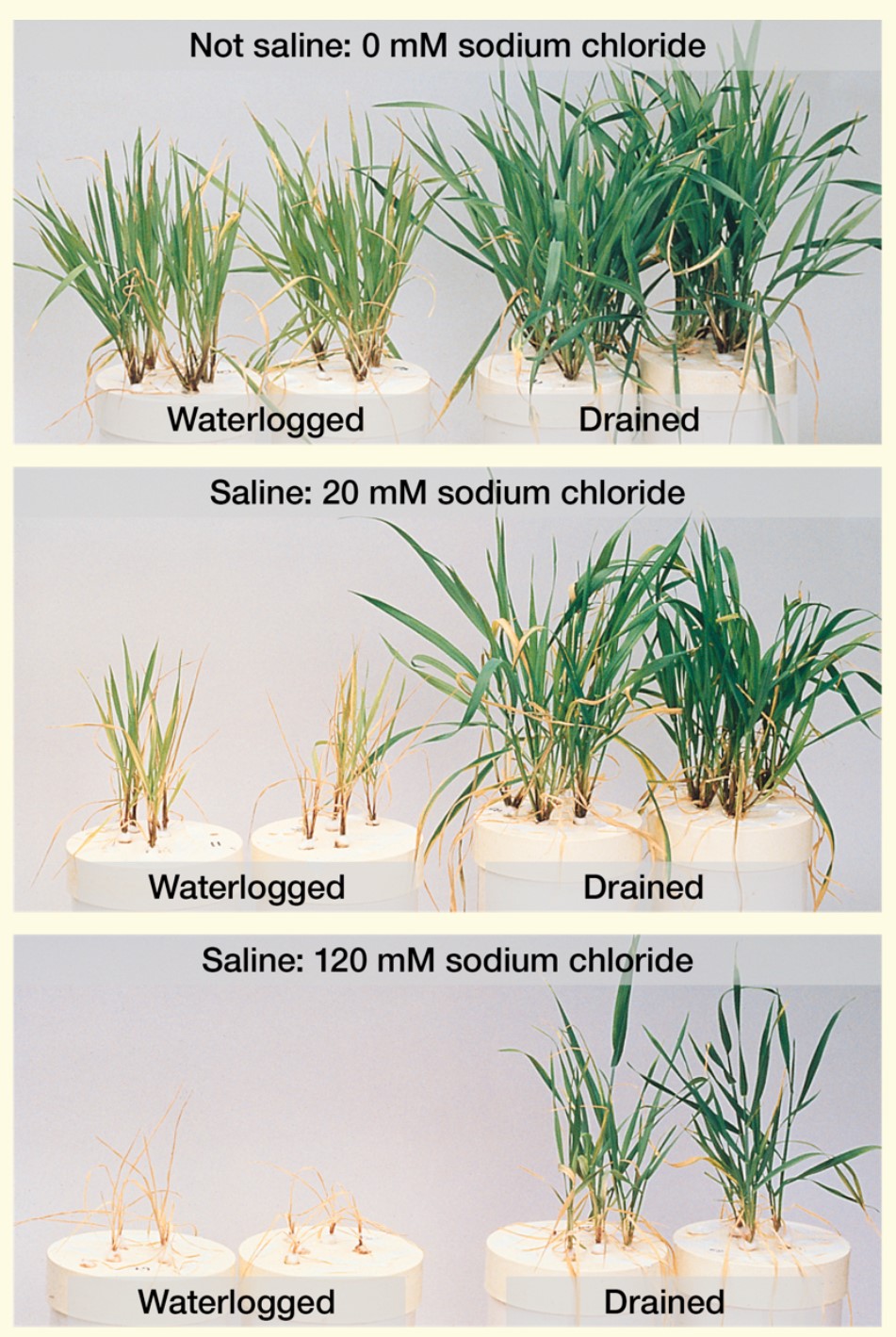Poorly drained or waterlogged soils lack the interconnected air spaces and large pores that are essential for the movement of water and gases, and the growth of plant roots.
Waterlogging occurs when soil becomes saturated (soil pores are full of water) because excess water cannot drain away or the groundwater level rises to near the surface. This may be caused by excessive rainfall, poor irrigation management, seepage, and groundwater recharge resulting in a rising watertable.
The effect of waterlogging in the field is extremely complex, with soil physical and chemical properties interacting with the duration and depth of waterlogging, waterlogging frequency, and the growth stage and nutritional status of plants.

Soil water drainage
Soils that allow water to enter and drain from the profile at rates suited to the selected land use are ideal.
This means maintaining a soil which allows rapid entry of water (infiltration) and percolation (movement of water downwards through the soil) and is free of layers where permeability decreases.
Deep drainage refers to water that moves below the root zone of plants and recharges groundwater. This has the potential to cause rising water tables (inducing dryland salinity in some areas) and may increase the hydraulic gradient causing saline groundwater to flow into river systems, reducing water quality. Excessive deep drainage can also cause lateral flow and discharge.
Water moves into and through soil in response to hydraulic pressure gradients. These gradients may develop as a result of suction forces (water entry into a dry soil) or gravity (water entry in wet soil). This can result in either vertical (downward or upward) or horizontal (lateral) flow. The downward flow of water is primarily driven by gravity but as the soil surface dries out due to evaporation, water can move slowly upwards due to capillary action and diffusion. This kind of movement also occurs to some extent from groundwater and is called capillary rise (when groundwater is under a positive head, water can also be forced upwards as in artesian basins). Lateral flow occurs when water is unable to flow through an impermeable parent material such as rock or dense clay and is forced to flow sideways either on the surface of the impenetrable layer or within a more-permeable band between clay-rich layers.
Features of a well-drained soil
- Water does not pond on the surface
- No impeding layers such as a hard pan – natural, or induced by cultivation or traffic
- Healthy plant roots that penetrate deeply into the subsoil
- Healthy plant growth with no bare soil patches; absence of reeds or rushes
Warm orange to red colours are common in the subsoil if clayey and solid colouration if well drained. Well-drained soils do not show the grey and yellow colours in the subsoil that are typically associated with either permanent (uniformly coloured) or transient (mottled colour) waterlogging.
Impact of waterlogging on plant health
Waterlogging for a few days can cause soil to become oxygen deficient (hypoxic).
Oxygen deficiency causes plant roots to become energy deficient, which impacts on root cell metabolism, growth and survival. As a result of waterlogging, processes occur in the soil profile that affect crop production. Plant roots begin to die from the tips within the hypoxic soil layers, resulting in root pruning.
Plants become susceptible to waterlogging where the root zone is saturated within 300 millimetres of the surface. Soil that has less than 400 millimetres of sand over impermeable clay (shallow duplex) and contains gravel is particularly susceptible to waterlogging.
Later in the growing season, these affected plants are highly susceptible to subsequent heat stress and may ‘hay-off’ prematurely as the soil profile dries. Anaerobic conditions in soil can also limit nitrogen uptake due to plant available nitrate (NO3–) being converted to unavailable nitrogen gas (N2) by de-nitrifying bacteria. This process is called denitrification.
Waterlogging is of particular concern in slightly saline soil. In slightly saline soil, most crop plants exclude sodium and take up potassium through the action of energy-consuming processes at the root-surface. Energy deficiency associated with waterlogging, typically increases the uptake of sodium and decreases the uptake of potassium in many crops and pastures. These adverse waterlogging/salinity interactions exacerbate the adverse effects of salinity.
Perched water tables are not always harmful to crops. Indeed, there can be beneficial effects on crop growth from subsoil waterlogging. For example, there can be benefits to crop growth in water repellent sands where water rises by capillarity to wet the dry topsoil. Perched water also increases subsoil water storage which can be beneficial to crops in deeper duplex soil (>600 mm sand layer), particularly during grain fill at the end of the season.
Page references and acknowledgements
Material on this page adapted from:
- Hoyle FC (2007). Soil Health Knowledge Bank.
- Barrett-Lennard EG, Hall D, Parker W and Munir R (2022). Soil Quality: 8 Sodic and Alkaline Soil. SoilsWest, Perth, Western Australia. [Access]
Last updated July 2024.














